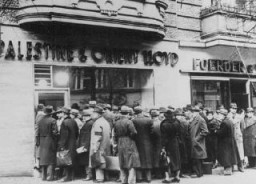
Photo
Browse an alphabetical list of photographs. These historical images portray people, places, and events before, during, and after World War II and the Holocaust.
<< Previous | Displaying results 1001-1025 of 2609 for "Photo" | Next >>
-
German boys read an issue of Der Stuermer newspaper
PhotoGerman boys read an issue of Der Stuermer newspaper posted in a display box at the entrance to a Nazi Party headquarters in the Dresden region. The German slogan (partially obscured) at the bottom of the display box reads, "The Jews are our misfortune."
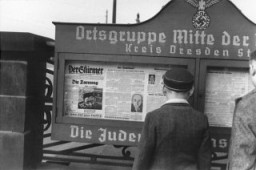
-
German children read an anti-Jewish propaganda book titled Der Giftpilz
PhotoGerman children read an anti-Jewish propaganda book for children titled Der Giftpilz (The Poisonous Mushroom). The girl on the left holds a companion volume, the translated title of which is "Trust No Fox." Germany, ca. 1938. (Source record ID: E39 Nr .2381/5)
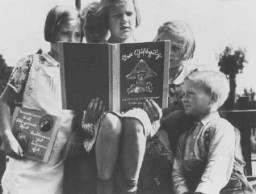
-
German civilians are forced to view a wagon piled with corpses
PhotoGerman civilians under US military escort are forced to view a wagon piled with corpses in the newly liberated Buchenwald concentration camp. Buchenwald, Germany, April 16, 1945.
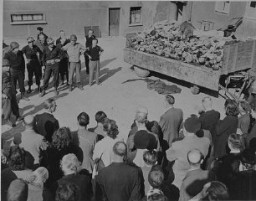
-
German civilians are forced to view bodies of victims of a death march
PhotoAfrican American soldiers of the US Army escort German civilians through a site where camp prisoners were massacred during a death march from Buchenwald. Such tours forced Germans to recognize the crimes committed by the SS. Near Nammering, Germany, 1945.
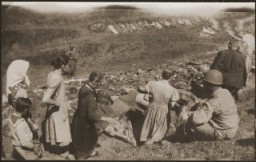
-
German civilians from Nammering dig graves for victims of a death march
PhotoGerman civilians from the town of Nammering, under orders of American military authorities, dig graves for victims of a death march from the Buchenwald concentration camp. Germany, May 1945.
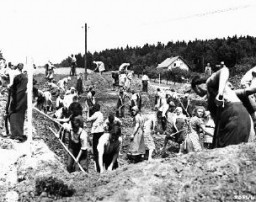
-
German civilians from Nordhausen carry victims of the Dora-Mittelbau camp toward graves
PhotoUnder the supervision of the US First Army, German civilians from Nordhausen carry victims of the Dora-Mittelbau concentration camp to mass graves. Germany, April 14, 1945.
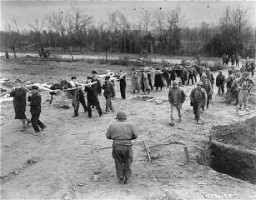
-
German civilians from Schwarzenfeld dig graves for the reburial victims of a death march
PhotoGerman civilians from Schwarzenfeld dig graves for the reburial of 140 Hungarian, Russian, and Polish Jews exhumed from a mass grave near the town. The victims died while on an evacuation transport from the Flossenbürg concentration camp. Schwarzenfeld, Germany, April 25, 1945. Following the discovery of death march victims, US Army officers forced local Germans to view the scene of the crime and ordered the townspeople to give the victims a proper burial.
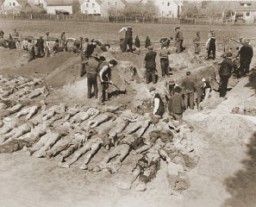
-
German civilians from Schwerin attend funeral services for Wöbbelin victims
PhotoUnder orders from officers of the US 8th Infantry Division, German civilians from Schwerin attend funeral services for 80 prisoners killed at the Wöbbelin concentration camp. The townspeople were ordered to bury the prisoners' corpses in the town square. Germany, May 8, 1945.
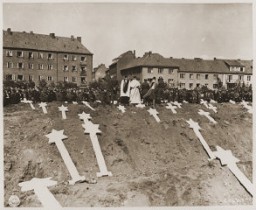
-
German civilians prepare to remove corpses of victims at Dora-Mittelbau
PhotoUnder orders of the US First Army, German civilians prepare to use a stretcher to remove corpses of victims of the Dora-Mittelbau concentration camp, near Nordhausen. Germany, April 13–14, 1945.

-
German civilians remove the bodies of prisoners killed in the Nordhausen camp
PhotoGerman civilians remove the bodies of prisoners killed in the Nordhausen concentration camp and lay them out in long rows outside the central barracks (Boelke Kaserne). Nordhausen, Germany, April 12, 1945. This image is among the commonly reproduced and distributed, and often extremely graphic, images of liberation. These photographs provided powerful documentation of the crimes of the Nazi era.
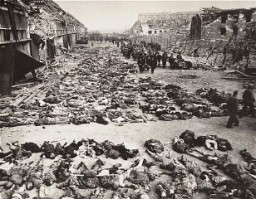
-
German civilians view a mass grave in Volary
PhotoUnder the supervision of American medics, German civilians file past the bodies of Jewish women exhumed from a mass grave in Volary. The victims died at the end of a death march from Helmbrechts, a subcamp of Flossenbürg. Germans were forced to exhume them in order to give the victims proper burial. Volary, Czechoslovakia, May 11, 1945.

-
German civilians were forced to assist in the burial of victims
PhotoGerman civilians from the town of Nordhausen carry the bodies of prisoners found in the Nordhausen concentration camp to mass graves for burial. Nordhausen, Germany, April 13-14, 1945.
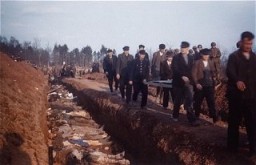
-
German civilians were forced to assist in the burial of victims at Ohrdruf
PhotoGerman civilians conscripted from nearby towns dig graves for some of the victims of the Ohrdruf camp. Ohrdruf, Germany, April 1945.
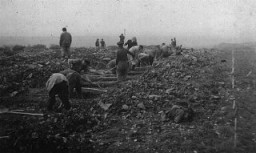
-
German destruction of symbols of the Polish state
PhotoThe Germans destroyed symbols of the Polish state. Here, German soldiers stand by the toppled Grunwald monument in Krakow. Poland, 1940.
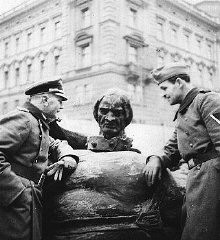
-
German documents collected by war crimes investigators
PhotoUS Army staffers organizing stacks of German documents collected by war crimes investigators as evidence for the International Military Tribunal.

-
German edition of The International Jew
PhotoBy 1922, The International Jew was already in its 21st printing in Germany. The edition shown here was published in Leipzig in 1922.
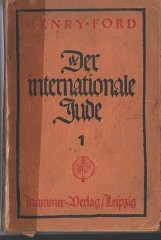
-
German forces enter Aachen
PhotoGerman forces enter Aachen, on the border with Belgium, following the remilitarization of the Rhineland. Aachen, Germany, March 18, 1936.
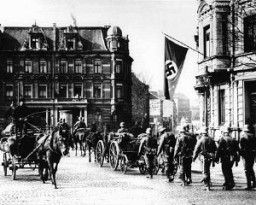
-
German General Headquarters, World War I
PhotoPictured from left to right: Field Marshal Paul von Hindenburg, Kaiser Wilhelm II, and General Erich Ludendorff study maps during World War I. January 1917.
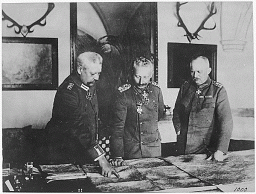
-
German girls posing outside their school in front of a Nazi flag
PhotoGroup portrait of German girls posing outside their school in front of a Nazi flag. Among those pictured is Lilli Eckstein six months before she was expelled from the school for being Jewish. Heldenbergen, Germany, 1935.

-
German Jewish adults and children wearing compulsory Jewish badges
PhotoGerman Jewish adults and children wearing compulsory Jewish badges are lined up against a building. Weser, Germany, 1941–43.

-
German Jewish refugee artist David Bloch
PhotoGerman Jewish refugee artist David Bloch. In November 1938 Bloch was interned for several weeks in the Dachau concentration camp near Munich. With the help of his brother in the United States, he escaped from Germany to Shanghai in May 1940.

-
German Jewish refugee Erwin Eisfelder in Shanghai
PhotoGerman Jewish refugee Erwin Eisfelder stands outside Cafe Louis on Ward Road. The cafe was named in honor of his father. It was a popular gathering place for refugees in Shanghai during the war years. Shanghai, China, ca. 1944.
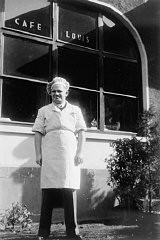
-
German Jewish refugee women in Shanghai
PhotoTwo German Jewish refugee women stand behind the counter of the Elite Provision Store (delicatessen) in Shanghai. Pictured on the left is the owner, Gerda Harpuder; on the right is her cousin Kate Benjamin. In 1939 Hans and Gerda Harpuder sold their crystal, silver, and other family possessions shipped from Berlin in order to open a grocery store in Hongkew at 737 East Broadway.

-
German Jewish women wearing the compulsory Jewish badge
PhotoTwo German Jewish women wearing the compulsory Jewish badge. Germany, September 27, 1941.
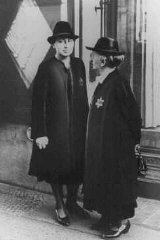
-
German Jews hoping to emigrate to Palestine
PhotoGerman Jews trying to emigrate to Palestine form long lines in front of the Palestine and Orient Travel Agency. Berlin, Germany, January 22, 1939.
